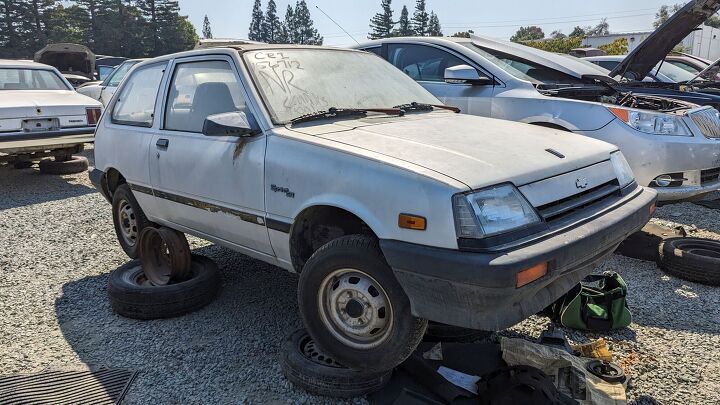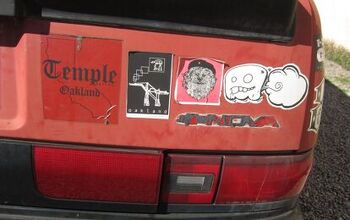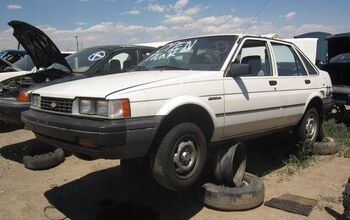Junkyard Find: 1987 Chevrolet Sprint ER

What was the most fuel-efficient (mass-produced, internal combustion-powered, highway-legal, non-gray-market, four-wheeled, et freakin' cetera) new car available in the United States during the 1980s? No, not the Toyota Starlet or Corolla Tercel, not the Honda CRX HF, not the Subaru Justy. It was the Chevrolet Sprint ER, and I've found a nicely intact example in a car graveyard just east of Sacramento.
If you want to be picky, the 1986 Sprint ER was the gas-mileage king of 1980s America, rated at 44 city and 53 highway miles per gallon. The 1987 Sprint ER came in second place, due to its insatiable thirst for go-go juice on the highway (51 miles per gallon).
In order to win the United States MPG crown for the 1985 through 1987 model years (for 1988, the Sprint Metro replaced the Sprint ER), the Sprint ER had a taller final drive gear ratio and a stingier camshaft than the regular Sprint.
It also had an upshift light (located in the lower right corner of the cluster) to remind drivers that fuel economy was more important than brisk acceleration.
Even though memories of the gas lines and fuel rationing of 1979 were still vivid by 1987, oil prices crashed hard during the middle 1980s, hitting bottom in 1986.
The MSRP for the regular '87 Sprint 3-door was $5,995, while the fuel-sipping Sprint ER 3-door listed at $6,110 (that's $16,593 and $16,912 in 2023 dollars). Not many Sprint shoppers were willing to pay the extra 115 smackers to get the ER's 47 combined miles per gallon instead of the base Sprint's 39 combined miles per gallon.
As I was contemplating the first Sprint ER I've seen in at least a couple of decades, the Air Force Thunderbirds screamed overhead as they practiced for the California Capital Airshow.
Less flashy Air Force hardware also roared by, since the junkyards of Rancho Cordova are beneath the flight path to Travis Air Force Base (which was named Fairfield-Suisun Air Force base until a B-29 carrying a "Fat Man" atomic bomb crashed and burned there, killing Brigadier General Robert F. Travis).
The heart of the Sprint was a carbureted 1.0-liter Suzuki three-cylinder engine, rated at 49 horsepower. The next-generation version of this car, the Geo Metro XFi, was the final new production car available in the United States with under 50 horses, using a fuel-injected version of the same Suzuki three-banger.
It appears that this engine was not legal for sale in high-altitude areas.
A five-speed manual was mandatory equipment on the 1987 Sprint ER. Other Sprint models could be purchased with optional automatics that year.
Back in its Japanese homeland, this car was known as the Suzuki Cultus. The second-generation version appeared here in 1989, badged as the Geo Metro. After the Geo brand got the axe in 1997, the Metro became a Chevrolet. Note the black rectangle on the hood; that's the hood release, not a badge.
The Sprint was nowhere near the cheapest new car Americans could buy in 1987. That honor went to the $3,990 Yugo GV, followed by the tied-for-second-place $4,995 Hyundai Excel 3-door hatchback and $4,995 Chevrolet Chevette (yes, new Chevettes were available that late). The Volkswagen Fox, base Subaru 3-door and Plymouth Horizon America undercut the Sprint's price as well.
As even the most miserable econoboxes got heavier and more powerful in later years, the 1986 Sprint ER's fuel-economy numbers seemed untouchable. The original Honda Insight beat it, but it needed a gasoline-electric hybrid powertrain plus a lot of cutting-edge aerodynamic and weight-reduction tricks to pull it off.
The Sprint ER shouldn't be compared to modern hybrids or EVs, though. It achieved its efficiency on straight internal combustion and did it with a carburetor.
Driving a Sprint ER from Los Angeles to New York with three passengers sounds like a nightmare. Just $66 with gas priced at $1.16 per gallon.
Also a better deal than seven horses (the hoofed variety).
Crushes the Hyundai Excel.
It loves to run!
In Canada, this car was badged as the Pontiac Firefly.
The Cultus was available with air conditioning, which would have been nice for those humid Japanese summers.
Versions of this generation of Cultus were sold everywhere, thanks to the long reach of the GM Empire
1987 Chevrolet Sprint ER in California junkyard.
1987 Chevrolet Sprint ER in California junkyard.
1987 Chevrolet Sprint ER in California junkyard.
1987 Chevrolet Sprint ER in California junkyard.
1987 Chevrolet Sprint ER in California junkyard.
1987 Chevrolet Sprint ER in California junkyard.
1987 Chevrolet Sprint ER in California junkyard.
1987 Chevrolet Sprint ER in California junkyard.
[Images: The Author]
Become a TTAC insider. Get the latest news, features, TTAC takes, and everything else that gets to the truth about cars first by subscribing to our newsletter.

Murilee Martin is the pen name of Phil Greden, a writer who has lived in Minnesota, California, Georgia and (now) Colorado. He has toiled at copywriting, technical writing, junkmail writing, fiction writing and now automotive writing. He has owned many terrible vehicles and some good ones. He spends a great deal of time in self-service junkyards. These days, he writes for publications including Autoweek, Autoblog, Hagerty, The Truth About Cars and Capital One.
More by Murilee Martin
Latest Car Reviews
Read moreLatest Product Reviews
Read moreRecent Comments
- Bd2 Lexus is just a higher trim package Toyota. ^^
- Tassos ONLY consider CIvics or Corollas, in their segment. NO DAMNED Hyundais, Kias, Nissans or esp Mitsus. Not even a Pretend-BMW Mazda. They may look cute but they SUCK.I always recommend Corollas to friends of mine who are not auto enthusiasts, even tho I never owed one, and owned a Civic Hatch 5 speed 1992 for 25 years. MANY follow my advice and are VERY happy. ALmost all are women.friends who believe they are auto enthusiasts would not listen to me anyway, and would never buy a Toyota. They are damned fools, on both counts.
- Tassos since Oct 2016 I drive a 2007 E320 Bluetec and since April 2017 also a 2008 E320 Bluetec.Now I am in my summer palace deep in the Eurozone until end October and drive the 2008.Changing the considerable oils (10 quarts synthetic) twice cost me 80 and 70 euros. Same changes in the US on the 2007 cost me $219 at the dealers and $120 at Firestone.Changing the air filter cost 30 Euros, with labor, and there are two such filters (engine and cabin), and changing the fuel filter only 50 euros, while in the US they asked for... $400. You can safely bet I declined and told them what to do with their gold-plated filter. And when I changed it in Europe, I looked at the old one and it was clean as a whistle.A set of Continentals tires, installed etc, 300 EurosI can't remember anything else for the 2008. For the 2007, a brand new set of manual rec'd tires at Discount Tire with free rotations for life used up the $500 allowance the dealer gave me when I bought it (tires only had 5000 miles left on them then)So, as you can see, I spent less than even if I owned a Lexus instead, and probably less than all these poor devils here that brag about their alleged low cost Datsun-Mitsus and Hyundai-Kias.And that's THETRUTHABOUTCARS. My Cars,
- NJRide These are the Q1 Luxury division salesAudi 44,226Acura 30,373BMW 84,475Genesis 14,777Mercedes 66,000Lexus 78,471Infiniti 13,904Volvo 30,000*Tesla (maybe not luxury but relevant): 125,000?Lincoln 24,894Cadillac 35,451So Cadillac is now stuck as a second-tier player with names like Volvo. Even German 3rd wheel Audi is outselling them. Where to gain sales?Surprisingly a decline of Tesla could boost Cadillac EVs. Tesla sort of is now in the old Buick-Mercury upper middle of the market. If lets say the market stays the same, but another 15-20% leave Tesla I could see some going for a Caddy EV or hybrid, but is the division ready to meet them?In terms of the mainstream luxury brands, Lexus is probably a better benchmark than BMW. Lexus is basically doing a modern interpretation of what Cadillac/upscale Olds/Buick used to completely dominate. But Lexus' only downfall is the lack of emotion, something Cadillac at least used to be good at. The Escalade still has far more styling and brand ID than most of Lexus. So match Lexus' quality but out-do them on comfort and styling. Yes a lot of Lexus buyers may be Toyota or import loyal but there are a lot who are former GM buyers who would "come home" for a better product.In fact, that by and large is the Big 3's problem. In the 80s and 90s they would try to win back "import intenders" and this at least slowed the market share erosion. I feel like around 2000 they gave this up and resorted to a ton of gimmicks before the bankruptcies. So they have dropped from 66% to 37% of the market in a quarter century. Sure they have scaled down their presence and for the last 14 years preserved profit. But in the largest, most prosperous market in the world they are not leading. I mean who would think the Koreans could take almost 10% of the market? But they did because they built and structured products people wanted. (I also think the excess reliance on overseas assembly by the Big 3 hurts them vs more import brands building in US). But the domestics should really be at 60% of their home market and the fact that they are not speaks volumes. Cadillac should not be losing 2-1 to Lexus and BMW.
- Tassos Not my favorite Eldorados. Too much cowbell (fins), the gauges look poor for such an expensive car, the interior has too many shiny bits but does not scream "flagship luxury", and the white on red leather or whatever is rather loud for this car, while it might work in a Corvette. But do not despair, a couple more years and the exterior designs (at least) will sober up, the cowbells will be more discreet and the long, low and wide 60s designs are not far away. If only the interiors would be fit for the price point, and especially a few acres of real wood that also looked real.























































Comments
Join the conversation
When you think about it it’s amazing how efficient the ICE has become. Back in the day of this Chevy Sprint you could only get such fuel economy by reducing the horsepower, cylinders, engine capacity and stuffing that engine into something small and light.
Today? I mean on Saturday I had to drive to a photo shoot precisely 160 km (100 miles) outside of Munich. I drive a 2018 Mercedes A250 AMG Line (W177) with a turbocharged 2.0 4-cylinder, 224-horsepower, 7-DCT (Double Clutch) and FWD. My car was fully loaded with heavy photographic gear including several heavy batteries for my Elinchrom 1200W portable flashes. The entire trunk and rear seats were filled with my equipment which means WEIGHT.
And yet my average fuel economy for 100 km was 6.6 liters (a solid 35 mpg). Sure, it’s not touching the fuel economy of the Chevy Sprint, but this involved spending almost 30 minutes in Munich traffic before reaching the Autobahn and then cruising at 140 km/h (87.5 mph) with several ventures into the 160-200 km/h zones in a car overloaded with heavy photographic equipment. That’s phenomenal fuel economy. Right now I am drinking water out of a 1.5 liter bottle. They are not very big and when you think about it… my car needed 4.5 bottles (1.5 liters each) to drive 100 km. Insane. As far as I am concerned this whole “But gasoline ICE engines are only 25-35% efficient in thermodynamics!” claim is irrelevant these days. Seriously.
Pic of my ride, her name is… “Priscilla”. 😆
My dad had one of these,tiny tinny little thing that he towed behind a motorhome then drove for years afterwards, from a different era of automobiles, nobody would accept the lack of amenities today